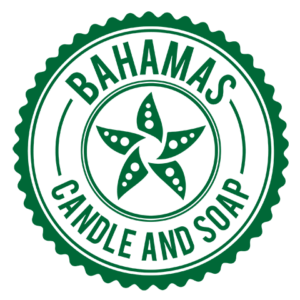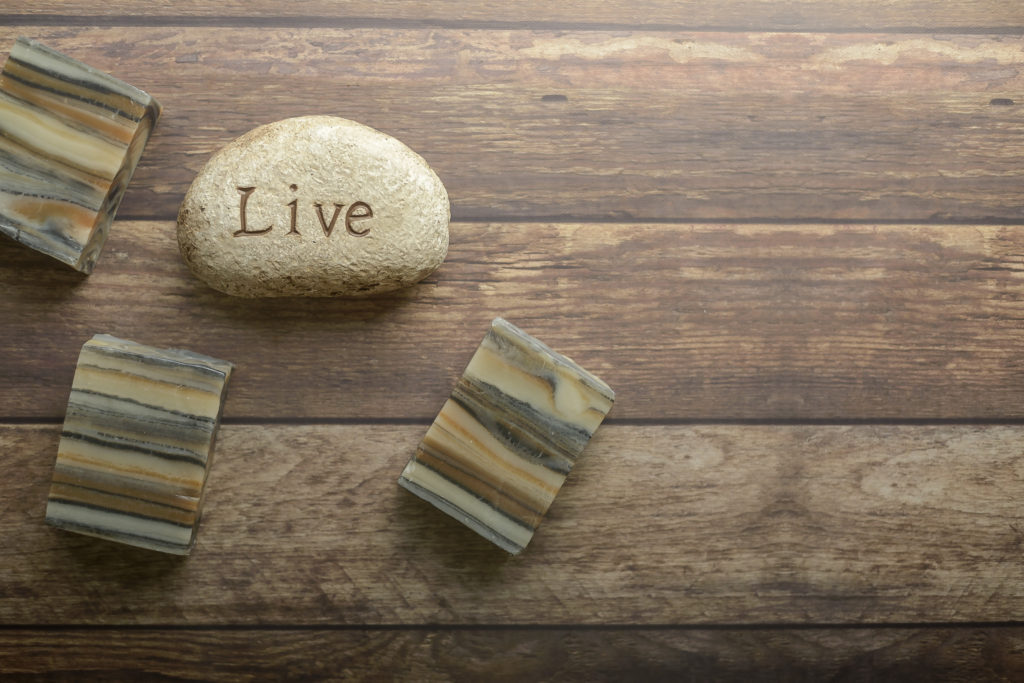
Wood grain soap recipe
Wood grain soap is not actually a soap with special properties but a technique used to make the soap look like wood grain.
Although the ingredients used can be considered special enought to aide in good skin cleaning and conditionoing it is often over shadowed by the design of the actual soap.
Making this type of soap does require careful pre planning to ensure all your tools and ingredients are close at hand and the technique is followed precisely to show that wood grain look.
The technique and recipe to make wood grain soap using cold process process requires activated charcoal, cacao powder and soft base oils. Lets take a closer look at how you can make this type of soap.
Wood grain technique cold process soap recipe – INGREDIENTS
| Ingredient | Pecentage | Weight |
|---|---|---|
| Olive Oil | 40% | 13.2oz |
| Coconut Oil | 25% | 8.25oz |
| Cocoa / Shea Butter | 20% | 6.60oz |
| Sweet Almond Oil | 10% | 3.30oz |
| Castor Oil | 5% | 1.65oz |
| Distilled Water | 12.54oz | |
| Lye | 4.64oz | |
| Cacao powder | 1tsp | |
| Activated Charcoal powder | 1tsp | |
| Fragrance Oil (Cedar Wood) | 1.5oz | |
| Sodium Lactate (optional) | 2tsp |
Tools needed for wood grain cold process soap making
| Amount | Soap Making Tools |
|---|---|
| 1 | 2qt Mixing Bowl |
| 1 | Spatula |
| 2 | Heat tempered mixing bowl |
| 1 | Stick Blender |
| 1 | Infrared Thermometer |
| 1 | Steel Whisk |
| 1 | 1tsp Measuring Spoon |
| 1 | 42oz Soap Mold |
| 1 | Food grade scale |
| 3 | Funnel pourer |
Cold Process Soap Making Safety
The one key point that is stressed as we teach and we will stress here at Bahamas Candle and Soap is the importance of safety in candle and soap making.
When making soap you will be working with super heated materials with the potential to cause major skin burns. You must be sure that you are properly prepared.
The main ingredient in soap making is sodium hydroxide also known as lye. This corrosive chemical reacts with water and begins to heat up drastically, however this chemical reaction is needed to convert oils into soap.
It is good to make safety procedures a standard and a habit when it comes to making cold process soap. Many soap makers have stated that after making soap for a while it becomes easier and less scary once they stick to safety protocols
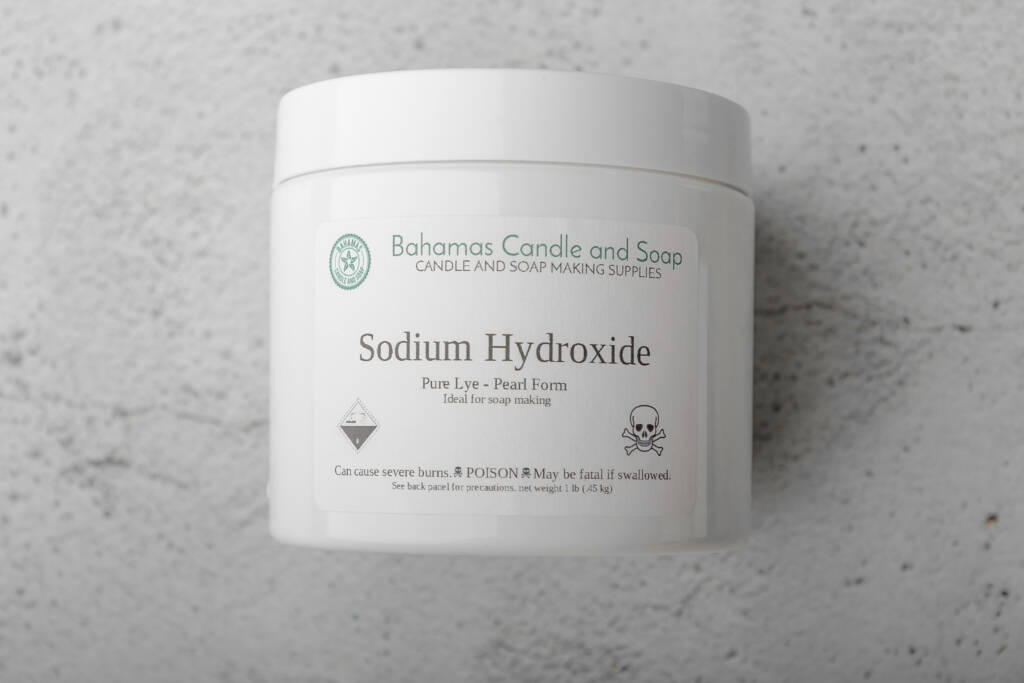
Sodium Hydroxide – Lye SAFETY
Sodium hydroxide is an inorganic compound used to emulsify the fats of oils into soap. When used properly in soap there will be no lye left over in the soap as its chemical makeup changes to create the actual soap.
When handling lye be sure to protect your exposed skin. Here are a few items we recommend you have.
- Gloves
- Long sleve shirt
- Long pants
- Closed toe shoes
- Safety Goggles
These items will ensure if there are any accidents such as splashes you will keep your skin safe from the burning sensation of lye.
NOTE
- Use an appropriate container to hold your lye and to mix your lye water. Heat tempered glass works very well or hard plastic containers.
- When making your lye water remember to add the LYE to the WATER and never the other way around.
- Mix you lye solution in a well ventilated area. The fumes that will arise from mixing water and lye can become noxious to some persons while its chemical scent can burn your nose and make your eyes water.
- Ensure that you are wearing your safety glasses, rubber gloves, long sleeve shirt and pants and close toe shoes. This is to avoid any splashes getting on your skin. Another reason is that if you use a container that cannot handle the heat created by the lye water solution it could break and the entire solution can get on your body.
- Learn more about lye safety HERE
Oils
In some recipies and depending on where in the world you live you may have to pre heat your oils. Oils can also burn the skin when heated hence ensuring that you are safe from splashes or spills is very important.
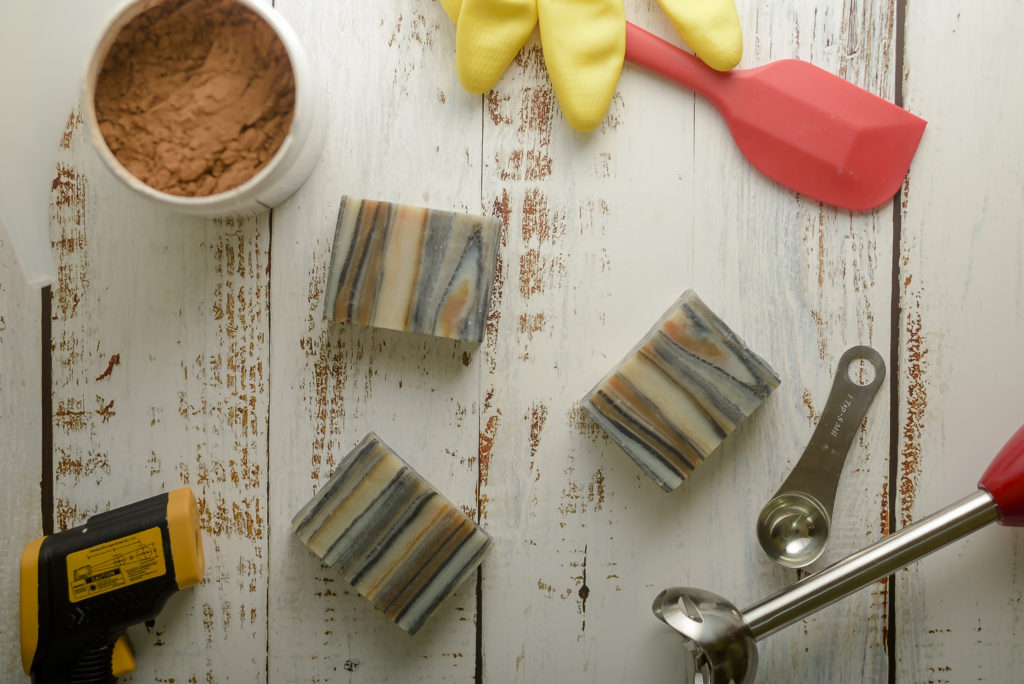
Instructions to make wood grain cold process soap
The wood grain technique will require some time to set up and to impliment. It is for this reason softer oils like olive and sweet almond oil are used in such large amounts. However coco butter and coconut oil are used to help harden the bar overtime.
The use of the soap will have strong stable lather and a bar that is hard and will last as long as you let it cure fully for 6 weeks. Yes thats right 6 this soap recipe and technique will require you let it cure for 6 weeks for best results.
As usual you can use it earlier but now that it may not last as long in the shower.
The initial preparation of ingredients and tools are similar to making any other cold process soap. The difference comes when combining the lye water and oils. This is the most critical part. There will be a part where you have to divide your soap batter into 3 separate containers evenly.
This means you ought to know the total weight of your soap. This total weight is listed on the soap calulator at 51.72oz. Divide this by 3 and you get 17.24oz per container.
Steps to making wook grain cold process soap
- Lye water preparation
- Oil preparation
- Add Essential oil
- Prepare mold and funnel pouring cups
- Combine lye water and oils
- Divide and color
- Pouring technique and design
- Remove soap from mold
- Cutting and curing
1 – Lye water preparation for cold process soap making
Remember to observe the safety protocol for handling sodium hydroxide.
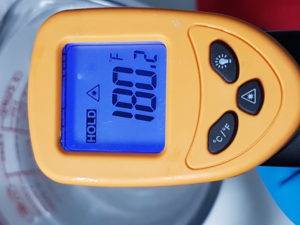
- Using your heat tempered measuring cups measure out by weight using your scale the remaining 10.54oz of distilled water (its ok if you are do not have exactly 10.54 but you should have close to 10oz of water by weight.
- Use your second measuring cup to weigh out 4.14oz of sodium hydroxide/lye.
- Add your lye to water (never the other way around) slowly and mix using the steel whisk until dissolved. Check the temperature of the lye mixture once the lye has been disolved. It can be up to 200 degrees farenheight.
- Set your lye water to the side to cool but safely away from any accidents such as bumping the tabe or knocking over the measuring cup. (NOTE – depending on your location and ambient heat, you can place your lye water in the refeigerator to cool quicker. You will want to check on it every 5 minutes taking its temperature using the infared thermometer. 120-130 degrees farenheight is a good temperature that you are looking for.)
- To ensure an even harder bar and to make it easier to remove from the mold add the 2tsp of sodium Lactate to the lye water mix.
Now that you have prepared your lye water you can get back to finalizing your preparation of the carrots.
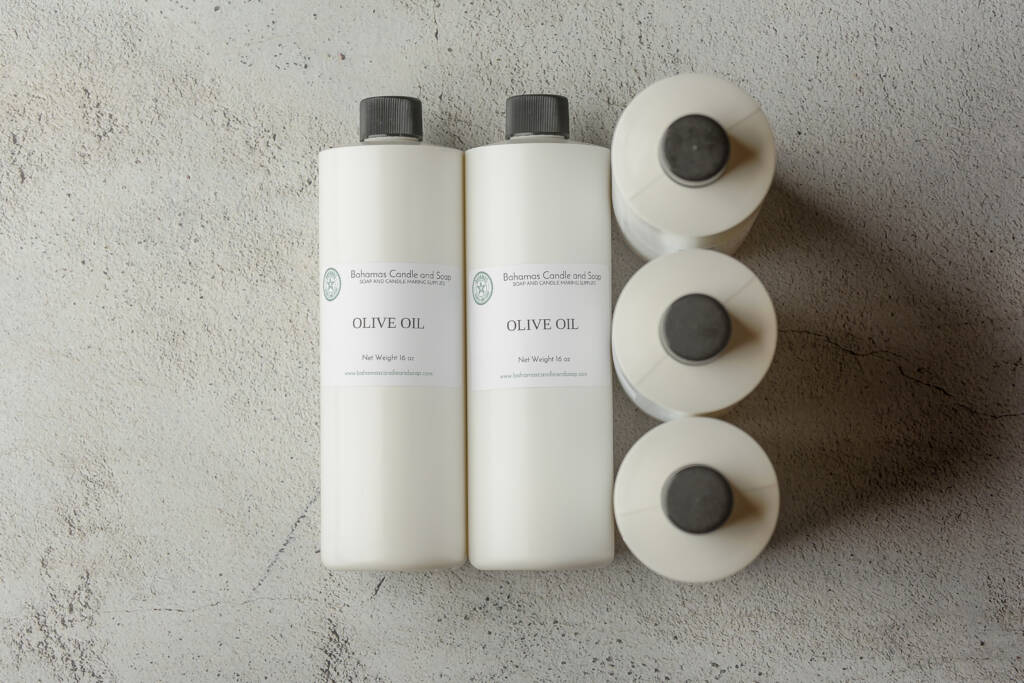
2 – Oil preparation for wood grain cold process soap recipe
Using multiple oils can become difficult to manage especially when it comes to combining all the oils together.
If you are unfamiliar with ways to combine multiple oils into one bowl properly you can visit How to combine multiple oils for soap making and familiarize yourselve with the techniques involved.
Which ever technique you use make sure you add all of your oils together in the 2 qt large mixing bowl. If you did not read the article on addind oil you may have missed the part about ensuring all your oils are melted and clear.
You will need your oils in a liquid state and at the right temperature roughly between 80-120 degrees farenheight, before continuing. Again if you are not sure how to do this skip over to the other article How to combine multiple oils for soap making.
With all you oils combined in the mixing bowl I find it a good practice to stir the oils togehter either with a spatula or more vigerously with a stick blender the more oils used. This is to ensure that the oils marry well within the mixture and are prepared for the lye water.
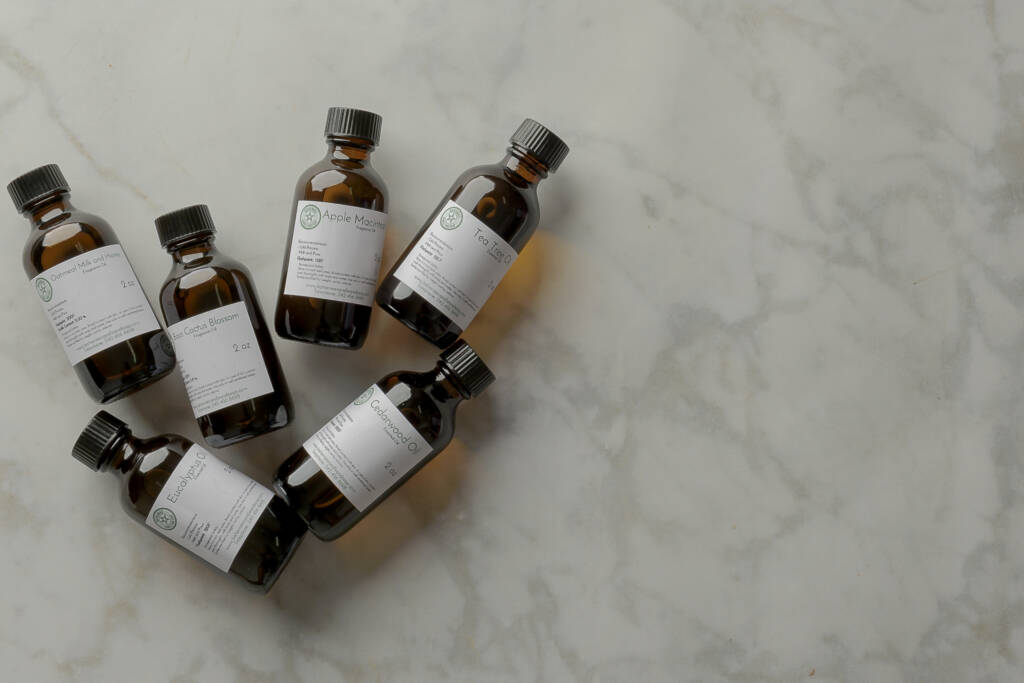
3 – Add cedar wood essential Oil
If you have an essential oil or fragrance oil that you would like to add to your recipe this is a good time to add it to the oil mixture.
There is one caveat to this however. Not all fragrance oils behave well in cold process soap making. You must ensure that you now how the fragrance oil will react to the soap.
Sometimes this means that it will accellerate trace, it will discolor or it some cases when adding the carrot puree it can cause the soap to begin to separate. Make sure you choose the right fragrance oil. We recommend using essential oils as they are more reliable
Measure out fragrance in a glass container. (do not use plastic container for essential oils) When measuring use wax paper on top of your scale to avoid the oil spilling on the plastic of the scale. Essential oil eats at plastic and will destroy your scale.
Make it a habit when using fragrance or essential oil to use a glass containter. Add the fragrance to your oil mixture in the mixing bowl and stir. Now you are ready to add your lye water.
NOTE – if your fragrance accelerates trace then adding it to the oil is not the best option. Wait until you have reached a light trace to add your fragrance.
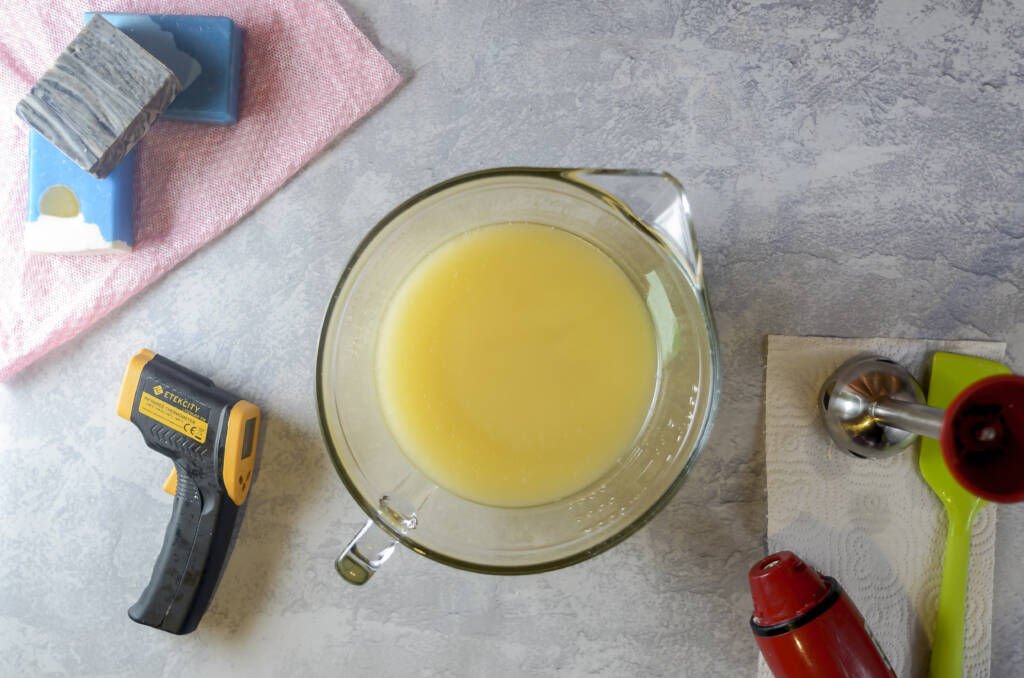
4 – Prepare pouring cups and mold
I mentioned that this technique requires you to be prepared. On you work bench within hands reach, fold your towel and use it to prop your mold up on one side. Make sure its the side furthers away from you.
This will give you a good view of the inside of the mold when done right. This is a part of how this technique works when pouring the soap batter in the mold. We will return to this set up a bit later.
Set aside 4 funnel pouring cups. Its good if they have a pouring spout because of the technique a spout tends to work best. If you do not have such pouring pitchers those paper cups can often work well. You will be using 3 of them for differnet colors of the wood grain soap and the forth will be the actual container to pour into the mold.
Set these aside but within arms reach as you will need them.
A pre prep that I tend to do is to add about 2 tsp of base oils to two of the funnel cups and 1 tsp of additive, activated charcoal in one and cacao powder in the other. Then disperse them in the oil either with your spatula or a mini mixer if you have one.
These two containers will be used to color the soap batter needed to help make the wood grain. Dispersing the activated charcoal and cacao powder in the oil makes it easier to spread it in the soap batter later rather than adding the dry additives directly to the batter.
Just remember to use a light weight oil such as sweet almond oil but your base oils that are mixed can work as well.
5 – Oil and Lye Mixture to make wood grain soap
- Take note of the temperature of your oils and your lye water. At this point they both should be between 80-100 degrees farenheight but closer to 100-120.
- With your stick blender in your oils well burped, pour your lye water into your Oil mixture along stick blender to prevent bubbles.
- Begin to blend the lye water and oils together with short pulses from your stick blender and then longer sustained mixing.
- Stick blend your batter until you have reached emulsification. (WARNING – this is critical. You must be able to tell when you have reached emulsification and not a light trace.)
6 – Divide your soap batter into three pouring containers
- Once you have reached emulsification its time to separarate your batter into your three funnel containers. place one container on the scale and measure out 1/3 of the batter which we calculated to be 17.24oz. Do this for the other two. Remember the two we prepared earlier with the charcoal and the powder? they will require thougrough mixing to incorporate the color and the light weight oil
- Take the containers with the dispersed powders and begin to mix them with a spatula. This will bring the colorant up throughout the entire batter within the pouring cup. Continue to mix until you can see most of the batter changing color. Do this for both the charcoal and the cacao powder.
- Stick blend all three of the containers to bring the batter up to a very light trace. This will also help disperse the colorant throughout the batter. (WARNING – pulse your stick blender so as to not over agitate it and take it to a traditional light or even medium trace. You will need the fluidity of a very light trace to continue from here)
7 – Pouring technique for the wood grain soap
The 4th pouring container will be your mold poring container. Follow the steps below continually until all your soap batter has been poured into the soap mold
- Having a pattern helps at this point. You can experiment with the order but for your first try lets work in the order of PLAIN, BLACK then BROWN.
- Hold and tilt the empty container while you pour a little of the plain soap batter into it using the sides of the container for the batter to slide down to the bottom.
- Add the same amount of BLACK soap batter, then BROWN soap batter. NOTE – the less you put in at a time the finer your wood grain will be. however for your first time make the pours a little larger.
- Repeat this technique over and over until the mold pouring container is almost full.
- Pour the mixed batter along the side of the tilted mold moving from one end of the mold to the other. You will see the colors begin to sit upon each other. Pours steadily and consistently. If you want a wood notch you can do a double take like a fold of soap batter but continue to fill in the mold one line of soap batter at a time.
- Repeat the filling of the mold container and pouring it into the mold moving side to side until you have reached the edge of the mold. This is where you will remove the folded towel slowly to level the mold. Then continue with the technique of pouring the soap batter until you have poured all of the batter into the mold.
- Depending on ambient temperature of your work room, cover with cardboard or wax paper over top then put to bed with towels to go through trace. (NOTE – If in a room at 75deg or more leave open and exposed as putting it to bed with a covering will most likely cause it to overheat and volcano. If in a cooler room cover the soap to let its own heat help take it to gel phase for brighter colors.)
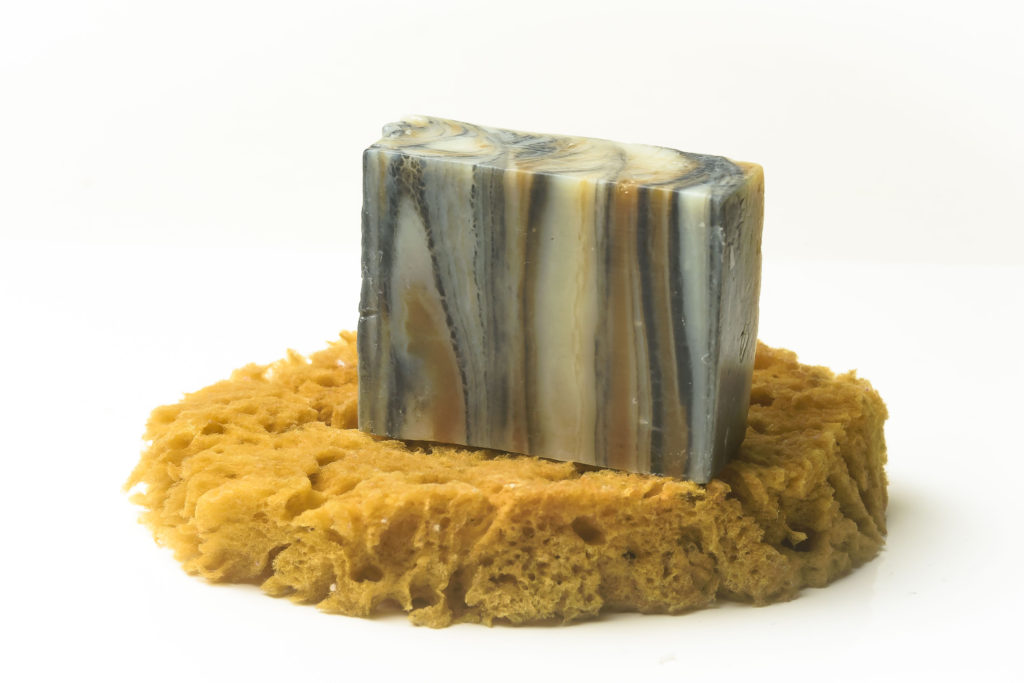
8 -Removing your soap from the mold
- Let you soap sit for 24-48 hours before attempting to removing from the mold.
- Check its readiness to be handled and removed by pressing lightly on the top of the soap. It should be slightly hard to the touch if it is still soft leave it in the mold for another 24 hours. Usually the sodium lactate helps to harden the soap.
- After 48 hours and the soap has not hardened enough, you can place in the refrigerator for an hour to cool to a point to make it easier to remove from the mold without damaging the soap.
- After cooling remove the silicon and soap fro the wooden mold by turning the mold upside down. The silicone part should slide out easily.
- Pull the sides of the silicone mold away from the soap slowly. If it looks sticky as you pull place the soap back into the refrigerator. If not continue to gently pull the sides away from the soap.
- Once all four sides are pulled away turn the silicone mold upside down and while pulling at the two narrow end of the silicone press down gently on the bottom of the silicone onto the soap.(this will help release the soap from the mold)
- As the soap begins to slide out of the mold help it along the way by pushing on the bottom of the mold until it slides completely out of the mold.
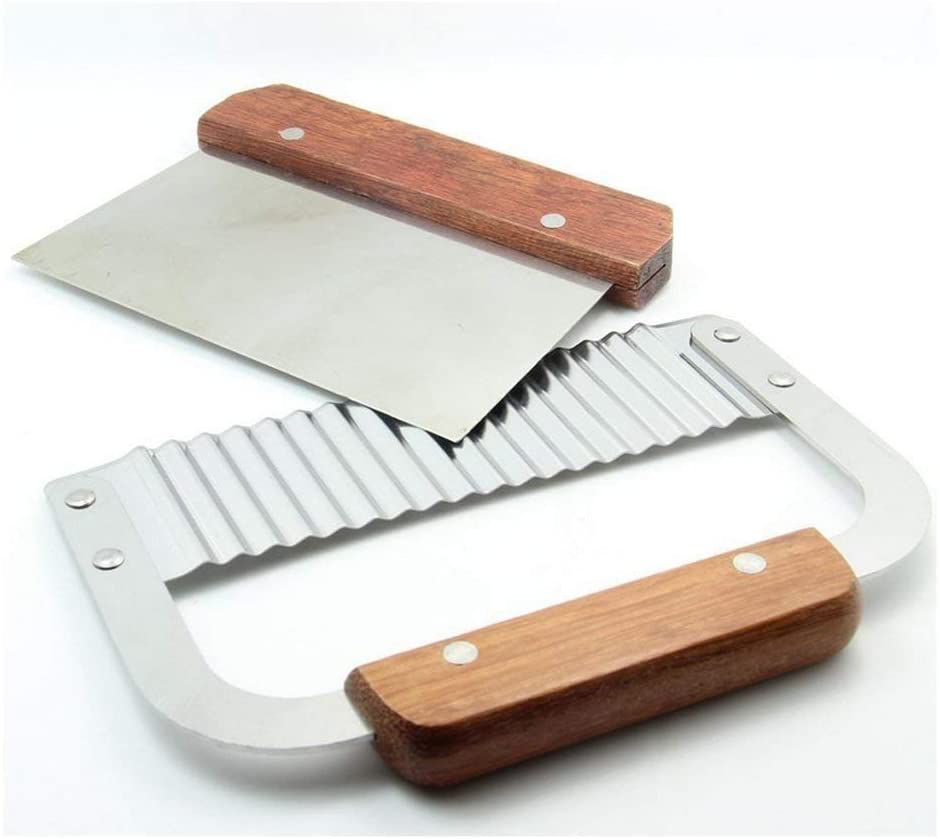
9 – Wood grain soap technique cutting and curing process
Cutting your soap is completely up to you. You can cut as thick or as thin as you like. The most standard thickness is often at 1 inch. For a typical soap loaf this will yield 10 bars of soap.
- Cut your soap using a soap cutter, a knife dedicated to soap cutting or a wire chees/soap cutter.
- Cut them 1 in thick, or to any thickness you like (Just do not leave it as one full loaf for long, the longer you wait the harder it becomes to cut the soap because it will begin to cure and get harder)
- Let your soap bars sit in a cool dry place for 4-6 weeks to cure. (Curing removes the excess water from the soap, this causes the soap to last longer.)
- Rotate your soap, changing the part that it sits on around to allow even evaporation of water from your soap.
- If you want to track its rate of curing you can weigh the soap bar diretly after cutting it and over the next few weeks weight it again. When the weight becomes negligable to track your curing process has completed.
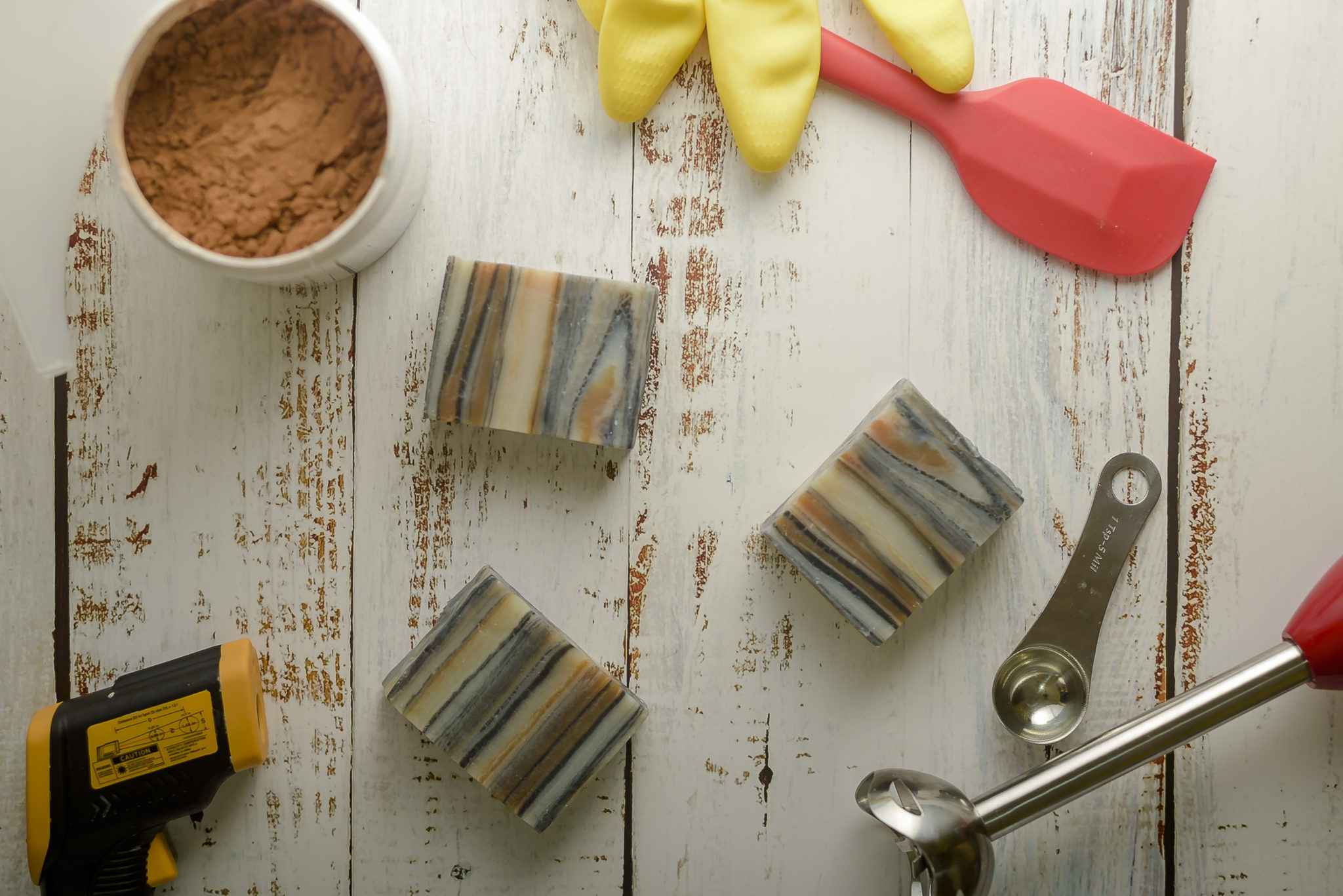
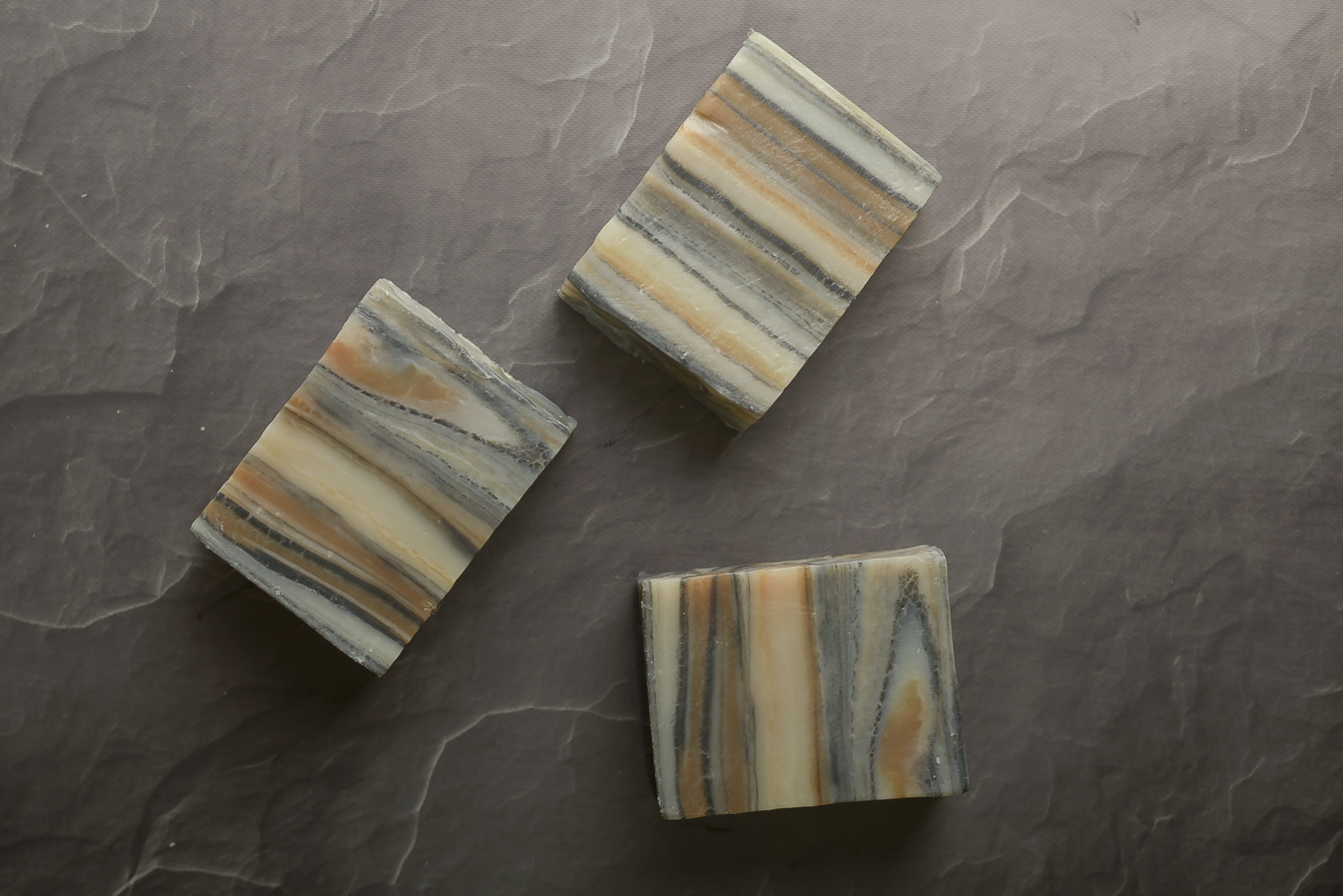
Congratulations on making your Wood grain cold process soap
Adding new ingredients to a soap recipie will open your soap making world to a myrand of options. Although we used carrot this time you can use any type of vegitable that can be boiled and pureed.
Practice this technique atleast two more times to make sure you get the hang of it. If any questions please do not hesitate to send us a message via our contact page or leave a message below in the comments section.
Recent Posts
Best Practices for Using, Storing, and Keeping Soap Molds for a Long Time
Soap making can be a rewarding and creative pursuit, allowing artisans to craft unique products while exploring their artistic side. One of the most critical components of this process is the soap...
Recommended Soap Molds Soap making can be an exciting hobby or even a profitable business but you wont get very far if you make a batch of soap and have no way to shape and mold it. This is where...
